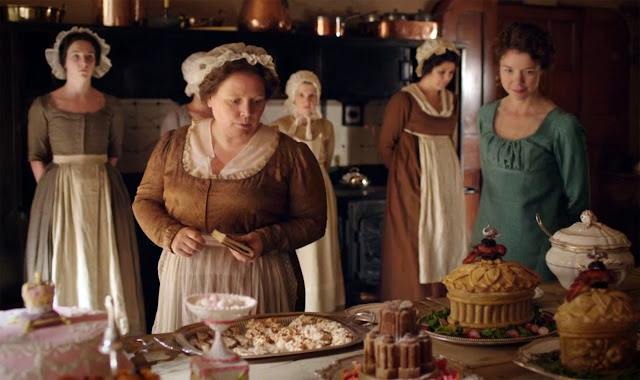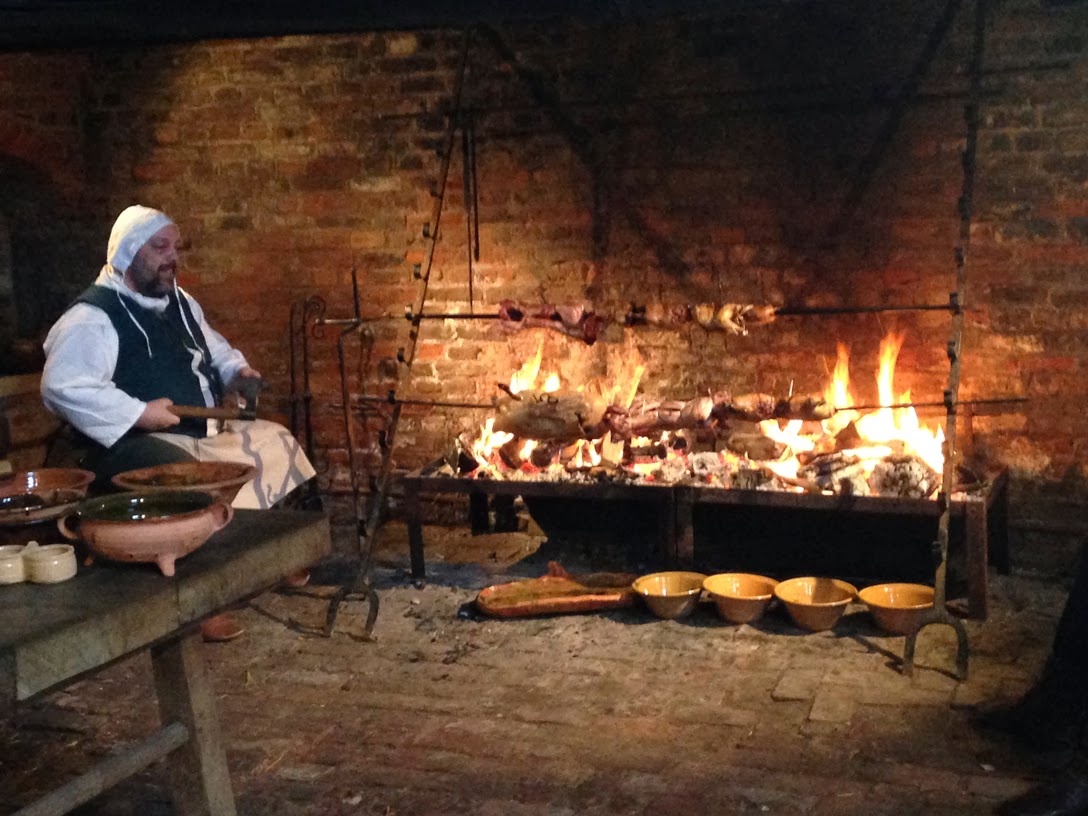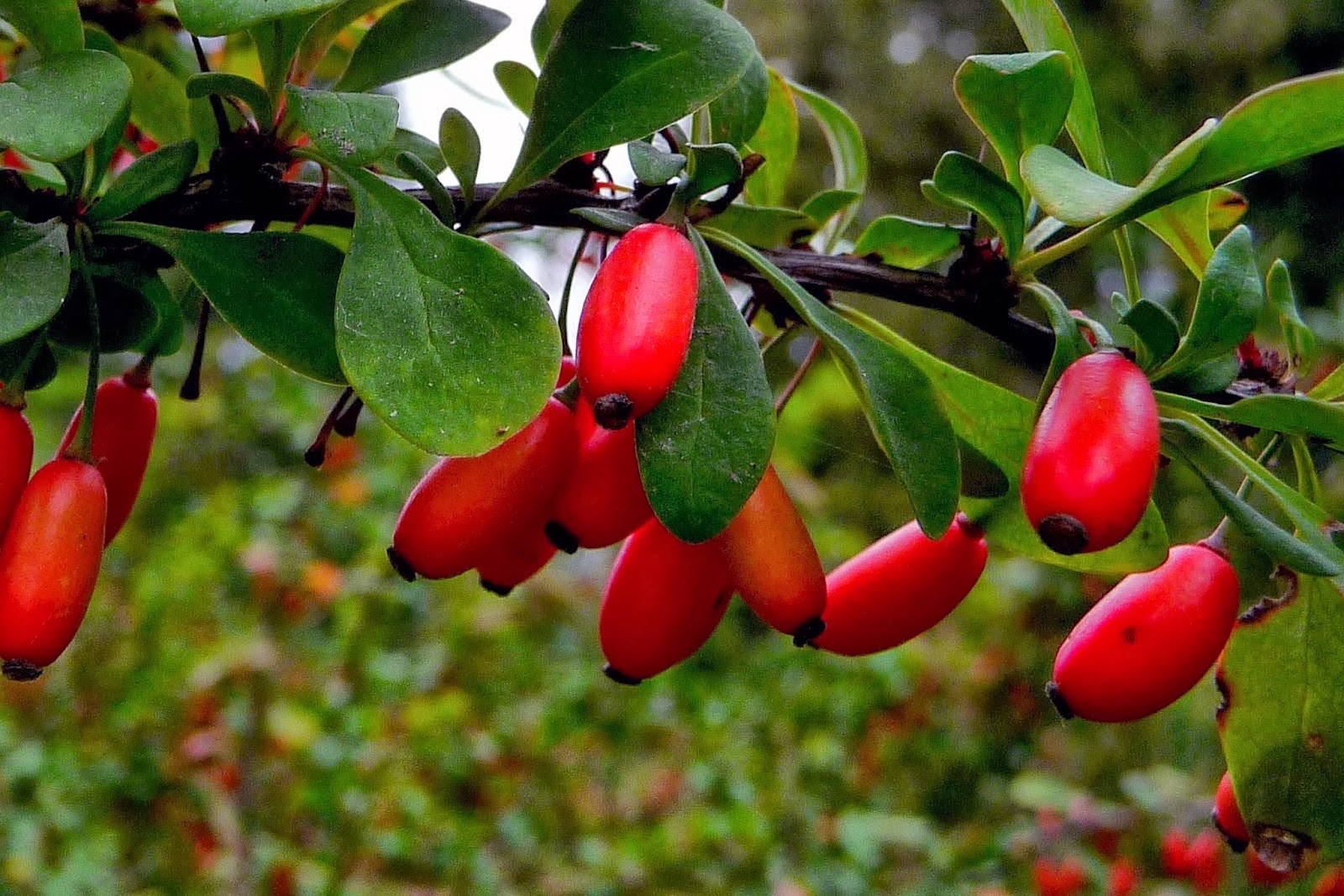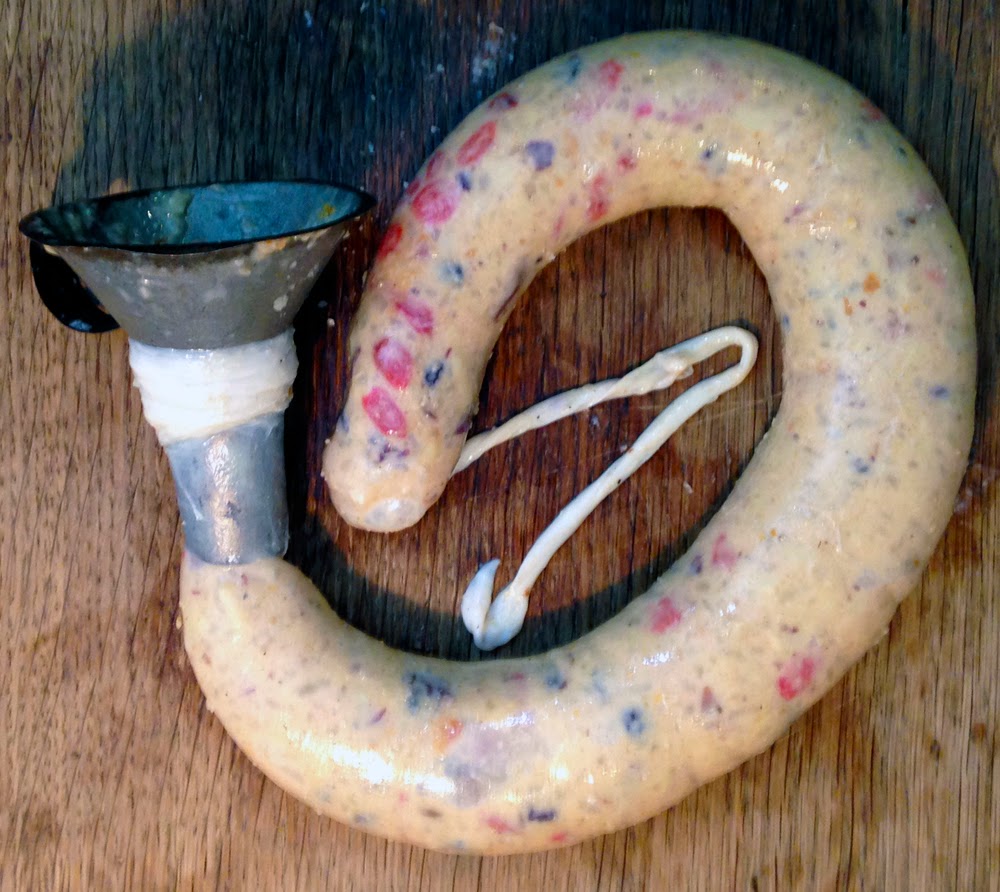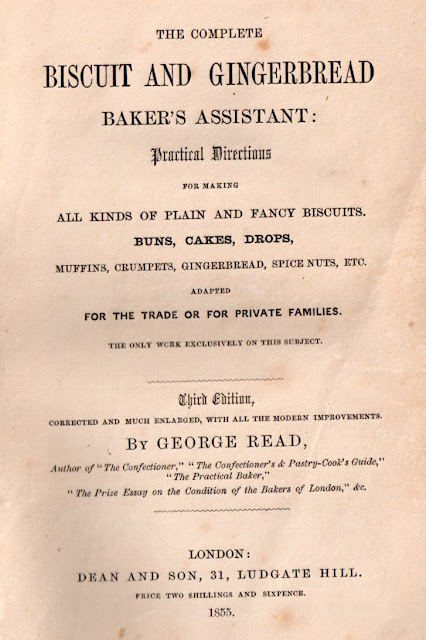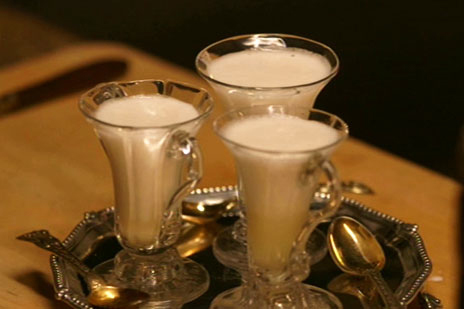Many British travellers wrote negative reports of the food they encountered on their journey from England to the great European centres. Some were so nervous that they carried copious supplies of plain British food for their channel crossing and the first leg of their onward journey. European rural inns particularly came in for criticism, as did the quality of much of the meat they encountered on the way. However, a lot of the food was just not to conservative British taste. English travellers were not used to garlic and olive oil and many yearned for good old roast beef and plum pudding. In some locations they actually managed to find British food. In 1771 Lady Anne Miller was delighted when she was able to eat English mince pies in Florence. Describing another meal in Rome in her diary she said,
This reminds me of those modern tourists who are relieved to find fish and chip shops in Benidorm! However, most had to survive on local food. No doubt many did experience excellent dishes, particularly in the great cities. The selection of European delicacies we prepared for our Grand Tour feast was aimed at the more adventurous time traveller - certainly not those who hope to find supplies of boiled mutton and bread pudding at their destination! This was our menu.
This nutritious consommé or bouillon designed to ‘restore’ the constitution, or weakened spirit, called, ‘quintessence or restaurant’ was served in specialised eating-houses in Paris during the eighteenth century. The soup gave its name to these establishments, thus ‘restaurants’. The earliest restaurants established before the French Revolution probably offered very few dishes other than restorative broths of this kind. They were sometimes referred to as 'houses of health'. Later ones offered much more extensive bills of fare. Restaurant must have been encountered by many British Grand Tour visitors passing through, or visiting Paris. Like bouillon it also formed the basis for many other soups and sauces. The recipe we used was that of François Marin,
(Paris: 1739). I have appended a full translation of his directions in the recipe section at the end of this post.
Broths of this kind were much in demand, especially for the delicate and infirm. They were often prepared by proprietors who were not licensed to sell a range of dishes, but could get away by offering just one. All kinds of broths were considered to be 'physical'. There is an extensive chapter on quasi-medicinal soups in Vincent la Chapelle's
(London: 1733). He gives one recipe for a 'Strengthening Broth, to warm the Blood of elderly and weak People', which starts 'Get about two hundred Sparrows ready pick'd and drawn'. I wanted to spare our guests (and the Welbeck sparrow population), so opted to serve Marin's 'Quintessence ou restaurant.'
2. Punche a la romaine - Roman punch
![]() |
| Punch romaine in some eighteenth century syllabub glasses on a silver waiter. The silver gilt spoon on the left is from a set made for the Prince Regent by Rundell, Bridge and Rundell. I made this punch romaine for the BBC documentary Pride and Prejudice, Having a Ball. |
Popular in Rome, Florence and Venice with travellers before Napoleon invaded the Italian peninsula and disrupted the flow of tourists, punch romaine travelled to Paris and became the most fashionable refreshment of the Empire period. It does not appear to have come to England until after Empress Josephine’s death in 1814 when a chef called Molas started work for Prince Lieven at the Russian embassy in London. The Italian confectioner Giugliamo Jarrin, who knew Molas, seems to have been the first to publish the secret recipe in an appendix in a later edition of his Italian Confectioner published in London in 1820.
3. Plato de truchas, y yervas - trout with leafy vegetables
![]() |
| Altmiras's Plato de truchas, y yervas (trout with leafy vegetables). Photo: Miriam White. |
Juan Altamiras, the author of this recipe, was the nome de plume of a Franciscan monk whose real name was Friar Raimundo Gómez. He is without doubt my favourite Spanish cookery writer. Gomez was born at the end of the seventeenth century and died in 1769. He ran the kitchens of a large religious school in the city of Zaragoza in Aragon in Northern Spain. His recipes are often sprinkled with wit and dry humor, as in these idiosyncratic instructions for cooking trout with bacon and meat dripping. He anticipates that some of his more pious readers would see this cooking method as being against the strict dietary regulations of the Catholic Church, so he makes a little joke about it. Of course the dish is designed for a day when meat was allowed and the bacon is an excellent addition. Many British protestant travellers were annoyed by the Catholic tradition of strictly adhering to fish days. They could not even get eggs to eat at breakfast! Altamiras’s book Nuevo arte de cocina was published in Madrid in 1745. The monks for whom he cooked must have eaten much better than the many Englishmen who dined out in Madrid. They constantly complained about everything they were served except the superb fruit. The recipes in Altamiras's wonderful little collection are fairly simple and represent the everyday cookery of his region of Aragon.
![]() |
| My copy of the 1758 edition of Altamiras's Nuovo Arte de Cocina. A previous owner has written over the printed date in the early nineteenth century with the probable year when he acquired the book. |
![]() |
| I have appended a translation of this in the recipe section at the end of the post. |
Freshly caught trout turn up in countless accounts of alfresco meals eaten by British travellers at various European riverside locations. While on his Grand Tour, James Hume praised the massive trout he enjoyed at Pont l’Eveque in 1714. Fresh fish repasts like this were rarely complained about.
4. Porchetto ripieno di macharonni - suckling pig stuffed with macaroni
![]() |
| Suckling pig stuffed with macaroni cooked in stock with cheese, pepper, chopped sausages, prosciutto and served with a ham coulis from Vincenzo Corrado, Il Cuoco Galante (Naples: 1786). Photo: Miriam White. |
![]() |
| Corrado's recipe for Porchetta Ripieno di Maccheroni. There is an English translation of this in the recipe section at the end of this post. |
The final destination for most British travellers on the Grand Tour was the city of Naples, famous for its
mangiamaccharoni,
cuccagna festivals and street ice cream vendors. The surrounding countryside provided the city with superb vegetables and fruit. In fact Neopolitans were noted for their enormous enthusiasm for greenery. Now we think of
salsa di pomodoro as the iconic dish of Naples, but the tomato was not commonly eaten with pasta until the late 19th century. Travellers to Naples were more impressed by some of the local meat and game dishes, a few of which featured pasta used in some unusual ways.
![]() |
| The title page of my rather well-used copy of the second edition of Corrado's Il Cuoco galante. |
Suckling pig has been popular in Italy since Antiquity. To be a true suckling pig, the animal must still be feeding on its mother’s milk. The 1st century AD Roman cookery writer Apicius gave seventeen different recipes for preparing this most delicate of meats. In his book Il cuoco galante (Naples: 1776). Dominican monk and Neapolitan cookery author, Vincenzo Corrado, also devotes a whole chapter to the animal, which he initiates by quoting a recipe from Apicius, in which the suckling pig is boiled in stock and served with a sauce flavored with wine, honey, rue, long pepper, and coriander. The good monk obviously tried this ancient Roman recipe, because he declares it to be “an excellent dish”. Corrado’s other recipes include a French inspired suckling pig fricassée, but are mainly from the local Neapolitan repertoire. In one distinctive dish, the pig is cooked over a charcoal stove and served with a sauce of quinces, cinnamon and pistachios. In another, the suckling pig is stuffed with pieces of eel, fennel seeds, garlic and bay leaves. However, nothing could be more quintessentially Neapolitan than the recipe above, in which the belly of the pig is filled with pasta, sausage and cheese. Colí di prosciuto was made by cooking small pieces of ham in brodo and reducing it after the ham had been removed. It demonstrates that the all pervading French practice of heightening the flavour of dishes with coulis, had intruded into native Neapolitan cookery.
![]() |
| The man himself. Corrado is one of my all-time food heroes and I avidly collect his books. When I get time, I will devote an entire post to him. |
5. Insalata alla Reale - Royal Salad
![]() |
| This incredible baroque fish salad is from Antonio Latini's Lo Scalco Moderna (Naples: 1682 and 1684). From the feedback we received after the event it seems to have been the most popular dish. Photo: Miriam White. |
This is a Southern ancestor of the well-known modern Tuscan bread salad. I have already touched on it in another post -
Salads to reach round the World. The b
iscottini, or ‘little biscuits’ in the recipe are ship’s biscuit, a hard dry rusk made by cutting bread into slices and putting it in the oven a second time to dry.
Friselle and
taralli are hard ring-shaped breads, which are both still made in Southern Italy. Like
biscottini they were usually softened in water. The radishes of this period were white and long-rooted rather than the round, bright red ones popular today.
Tarantello was a common ingredient in Italian recipes of the early modern period. It was made by salting part of the belly of young tuna fish. The city of Taranto was the centre of production, but this ancient delicacy is no longer made in modern Italy. I make my own.
Botarga, however, is still readily available; the most prized being made by salting tuna roes. Citrons or
cedri were commonly grown in Southern Italy and both the preserved peel and fresh flowers were popular ingredients in both sweet and savoury dishes. Sugared comfits were a common garnish for dishes of this kind – those of anise or fennel being the most popular.
![]() |
| Latini's original recipe. I have included a translation at the end of the post in the recipe section. |
![]() |
The author of this salad, Antonio Latini, was the scalco (house steward) to the Spanish regent of Naples. His two volume book is a remarkable collection, not only of recipes, but also of menus and carving instructions. It is one of the most beautiful of all baroque books on food and dining. |
![]() |
| Italian and Spanish Royal Salads were the inspiration behind the English Grand Salads of this period, like this winter salad of preserves and pickles with its standard of rosemary flecked with whipped egg white to represent snow. |
6. Spongata and parmesan ice cream
![]() |
| Two continental delicacies that could have been enjoyed in London confectionery shops on the grand tourist's return - spongata cake and parmesan ice cream. Photo: Miriam White. |
Tourists travelling back to London could continue to enjoy French and Italian food when they arrived home. A number of London-based Italian warehousemen sold imported luxury goods, such as olive oil, olives, vermicelli, truffles, morels, capers and fine wines. There were confectionery shops run by Italian natives in St James, New Bond Street and Westminster, which catered specifically for returning ‘macaronis’. One establishment in Berkeley Square, the Pot and Pineapple, founded by Domenico Negri in the late 1750s, sold high class Italian confectionery, ices and even sugar sculpture for the dessert tables of Mayfair aristocrats. Negri eventually returned to Turin and sold his share in the business, but it continued to trade well into the next century. One of Negri's apprentices, Frederick Nutt included a recipe for parmesan cheese ice cream in a collection of recipes he published anonymously in 1789. It is possible that it was an ice he learnt from his master Negri. The earliest European recipe for parmesan cheese ice cream was published in Joseph Gilliers,
La Cannamaliste Français. Nancy: 1751. There is a modern misconception that this is a savoury ice cream - it is not. I started making parmesan ice cream in the 1970s and taught it on my ice cream courses in the early nineties well before the chefy craze for such unusual flavours. I love it. I use Frederick Nutt's 1789 recipe
The Italian confectioner and ornament maker Gugliamo Jarrin, who had worked for Napoleon, arrived in London in 1816. In 1820, he published
The Italian Confectioner, the most important work ever to appear in print on the extraordinary art of confectionery as practiced in the long eighteenth century. Nothing as detailed was ever published in Italian. Spongata or spongati, was a local speciality from Jarrin’s home town of Colorno, near Parma. Local tradition claims it could be traced back to Roman times. Here is Jarrin's recipe, which of course he wrote in English. There is another post about it on this blog at
Spongata.
Fine Spongati Italian CakeOne pound six ounces of white bread, dried in the oven and reduced to a coarse powder; one pound four ounces of walnuts, blanched, and chopped very fine with a double handled knife; six. ounces of currants, well washed and cleaned; five ounces of wild pine kernels ; five pounds five ounces of virgin honey, clarified ; three grains of cinnamon in powder, one grain of cloves ; one grain of strong pepper ; and one grain of nutmeg in powder. The above articles must be mixed together, and enclosed in a crust paste, made of the following materials, viz., two pounds eight ounces of the best wheaten flour ; six ounces of fresh butter ; five ounces of loaf sugar, pounded; one ounce of olive oil, of Aix, in Provence, and half an ounce of salt, with a sufficient quantity of white wine to mix the whole. This paste, being of a moderate consistence, is to be formed into round cases or crusts, into which the first mixture is to be introduced, and a cover of the same paste must be put on, which must be pricked all over with the point of the knife. Let them stand for a whole day, put them in an oven, moderately heated, on plates dusted over with flour : these cakes should be an inch thick ; they may be iced or not, as you please.
From William Jarrin,
The Italian Confectioner.
(London: 1820).Parmesan Ice Cream
Take six eggs, half a pint of syrup and a pint of cream put them into stewpan and boil them until it begins to thicken ; then rasp three ounces of parmesan cheese, mix and pass them through a sieve, and freeze it.
From Frederick Nutt
, The Complete Confectioner. (London: 1789).
Recipe Translations
Apart from the last two recipes, which were both published in English, here are the translations of the French, Spanish and Italian recipes.
Take a well-tinned and very clean pan. Put into it several slices of onion, with a little beef marrow, slices from a round of nice white veal. On top of the veal slices, place several cleaned ham rinds from which the fat has been removed, and also some slices of parsnips and carrots. Take a good healthy freshly killed hen, and clean it well both inside and out. Cut it into pieces and crush the pieces. While still warm, put them into your casserole and then put in a few more slices of veal and small pieces of ham rind. Note that for two pints of this quintessence, you will require only about four or five pounds of veal and four ounces of ham as well as the hen. All being well arranged in your pan, add a glass of your stock, seal your casserole well and put it on a strong heat. If you cook it over a low fire, the meat yields its juices, but does not brown, so the liquid sticks to the meat and hardens during cooking and does not fall to the bottom of the casserole to form the restaurant that is required. When the meat has browned, put your casserole over a moderate fire for the space of three quarters of an hour. Take care that nothing sticks to the pan and from time to time moisten it with some bouillon, just to the point that the restaurant is not bitter or too strong, but sweet, unctuous and proper for a variety of sauces., which are normally made with ingredients that have their own taste and savour. Many cooks may put in this quintessence strongly flavoured things, such as garlic, cloves, basil, mushrooms, but I prefer the simpler fashion as I believe it is best for both taste and for health.
From François Marin,
Les Dons de Comus. (Paris: 1739).
Note. A French pint of this period is equivalent to a modern British quart. A French livre, or pound, was slightly heavier than a modern British lb – 1.07 lb.
Plato de truchas, y yervas
Take some large trout, scale them, split them and cut into little pieces. Fry them in lean and fat bacon. Take some white lettuce hearts, which are the best, and cook them in salted water. When the trout are fried, fry some slices of white bread, then add the lettuce to the pan with the remaining fat and fry them so that they do not dry out. Remove them and place them on a layer of bread slices, then another of hearts of cabbage, then pieces of trout, then add pepper and oranges, and in the middle, pieces of the fried bread, and a few pieces of lean bacon among the cabbage, then more trout. Serve hot. To make this dish even tastier, use dripping instead of oil. But I can already hear your qualm of conscience, which goes something like this: Brother Cook, here you are dealing with fish dishes, in which bacon is forbidden, so how can we legitimately use dripping and bacon? This little scruple, which, not being observed, would be a source of great pleasure to you, I wish to overcome as follows:
It is true that in this chapter it is my intention to cover fish dishes, and so I am dealing with trout, which by their nature may be eaten on days of abstinence from meat, but the method of preparing them described above is normally used on non-fasting days, and so this is something with which you cannot burden my conscience, for although I am a cook, I cannot allow you this pleasure, although it costs so little, because the pleasure and expense given by this poor cook are very much in conformity with Gospel teaching, as you will observe.
From Juan Altamiras, Nuovo Arte de Cocina. (Barcelona; 1758).
Porchetto ripieno di macharonni
Stuff the suckling pig with macaroni, first cooked in stock and well seasoned with cheese, pepper, chopped sausage, ham, and minced beef marrow and baste it with really good stock while it is roasting on the spit, or bake it in the oven, and serve it covered with an excellent coulis of ham.
From Vincenzo Corrado, Il Cuoco Galante. (Naples: 1776).
Insalata alla Reale
Take endive, or scarola (another variety of endive or chicory), mince it finely and put it to one side, until you have prepared a large basin, at the bottom of which are eight, or ten biscottini, friselle, or taralli, soaked in water, and vinegar, with a little white salt; put the said chopped endive on top, intermix with other salad stuff, albeit minced finely, make the body of the said salad on top at your discretion, intermix with radishes cut into pieces lengthways, filling in the gaps in the said basin with the ingredients listed below, all arranged in order. Pinenuts four ounces, stoned olives six ounces, capers four ounces, one pomegranate, white and black grapes ten ounces, twelve anchovies, tarantello (salted belly of tuna) four ounces, botargo three ounces, comfits, six ounces, preserved citron (and) preserved pumpkin twelve ounces, four hard boiled eggs, whole pistachios four ounces, four ounces of raisins, other black olives six ounces. Caviar, four ounces, minced flesh of white fish, six ounces, little radishes, salt, oil, and vinegar to taste, garnish the plate with slices of citrons, and citron flowers round about in order, take heed not to add salt or seasonings, until it goes to the table, and is about to be eaten.
From Antonio Latini,
Lo Scalco Moderna. (Naples: 1694).
Look out for more events of this kind and some of my historic cookery courses at the
The School of Artisan Food Website. There will be more!
[1] Jeremy Black, The Grand Tour in the Eighteenth Century. (London: 1992) p. 151.











